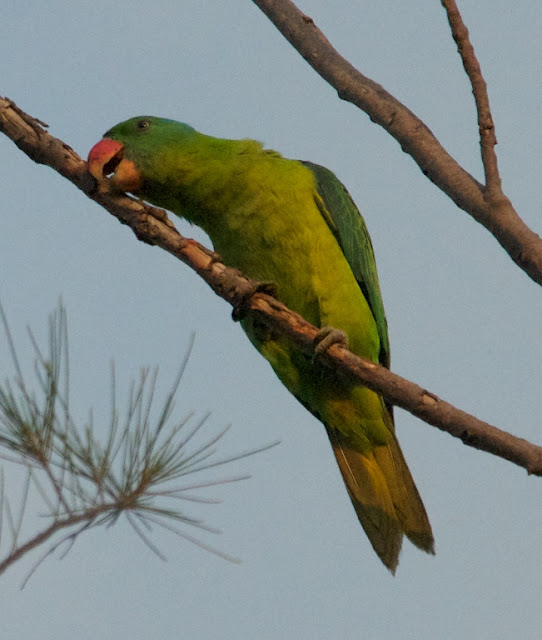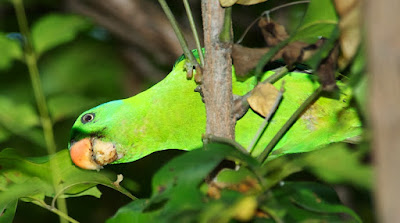Before we found our first parrot, though, we came across another unlikely urban bird - this time, a bona fide native.
Oriental Pied Hornbills (Anthracoceros albirostris) apparently come down to Tanjung Aru during the fruiting season (though they certainly aren't after the dry, conelike fruits of the casuarina tree this bird is sitting in - a few fruiting figs in the area provide a much more likely source of nutrition).
Fruiting trees also, presumably, brought in this Green Imperial-Pigeon (Ducula aenea), which I found preening in the fading afternoon light just as we were leaving.
By late afternoon, the parrots seemed to be resorting to the tops of the casuarinas, perhaps to catch the last rays of the setting sun. The Blue-naped is a medium-sized parrot, with (like other is its genus) an enormous red beak. The blue nape is more obvious on some subspecies than others (according to Clive Mann's The Birds of Borneo (British Ornithologists' Union, 2008), the birds at Tanjung Aru belong to the race salvadorii, but that race is not universally recognized).
The wild range of the Blue-naped Parrot is in the Philippines, and on the Talaud Islands northeast of Sulawesi; there are also populations, presumably introduced, on a few tiny Malaysian islands off the northeast coast of Sabah. It has already disappeared from a number of small islands in its range. Birdlife International lists the species as Near Threatened, noting that " is suspected to be in decline owing to trapping for the cagebird trade and habitat degradation from agricultural expansion and logging pressures".
The birds at Tanjung Aru seem relatively safe, but trapping of wildlife for the pet trade is a particular problem on the Philippine island of Palawan, which may hold the largest population of this parrot. Recently authorities confiscated a shipment of smuggled Palawan Forest Turtles (Siebenrockiella leytensis) that contained more animals than the entire known population of the species!
On our way out of the parking lot I found one of the parrots still feeding, just above eye level, and was able to take some flash photos at much closer range. You can see a bit of the blue nape in the bottom photo.
Tanjung Aru is a very attractive beach, and perhaps its popularity with people who come there for other reasons than to watch birds (such people do exist) may inadvertently provide enough protection from trappers to give the parrots a chance to survive. it would be nice to thinjk that they will survive in their native range with the same ease.

















Dear admin, i would like to ask your permission to take the bird picture for my presentation of pros and cons tanjung aru eco dev. tq
ReplyDeleteThe state government planned to excave and reclaim tg aru beach for condos, resorts and gold0f course. There will no safe place for these parrot to survive.
ReplyDelete